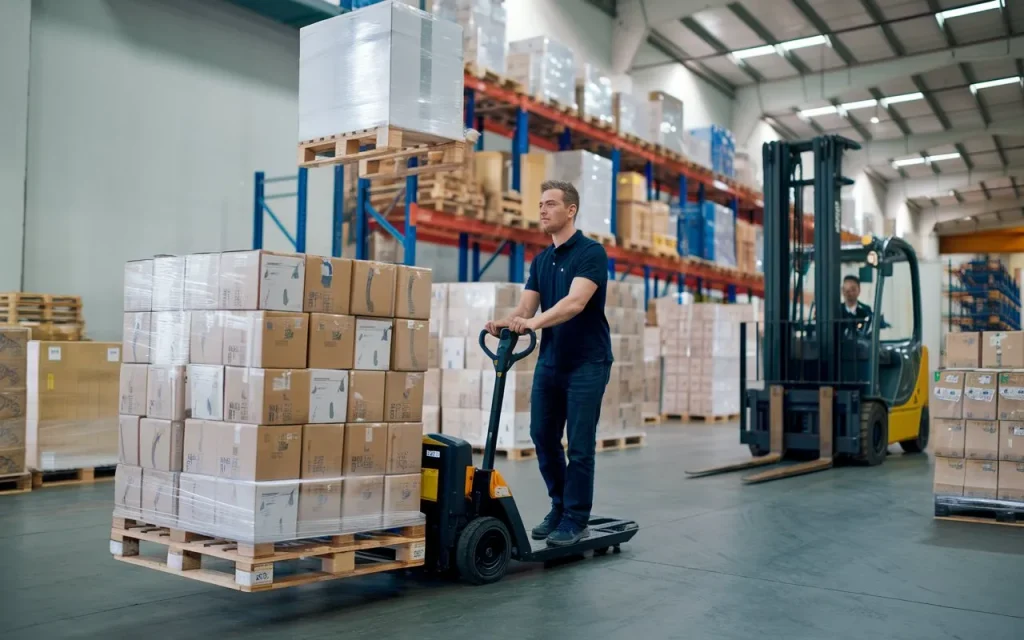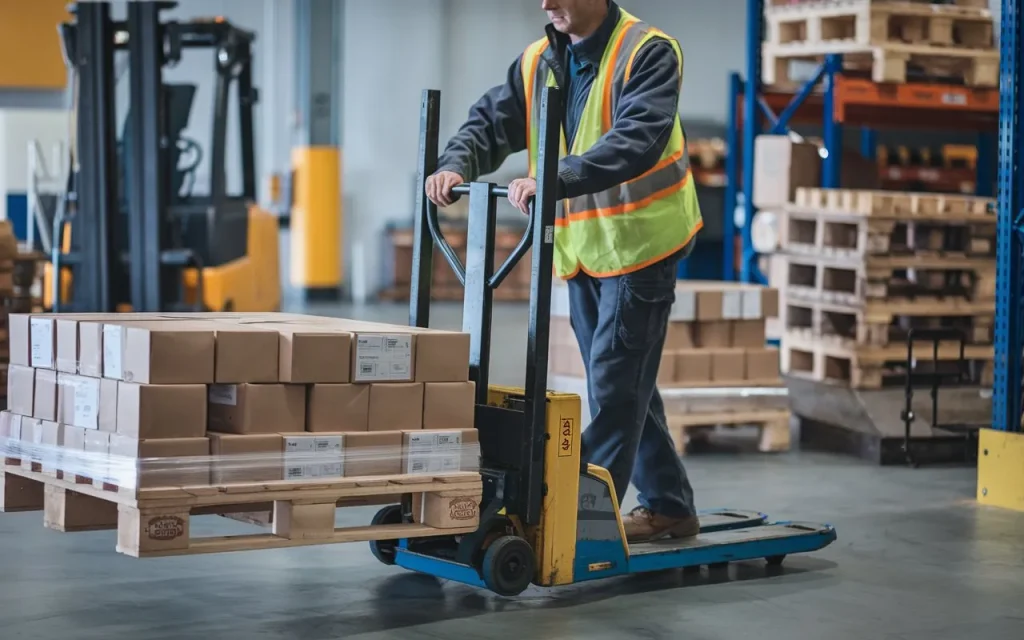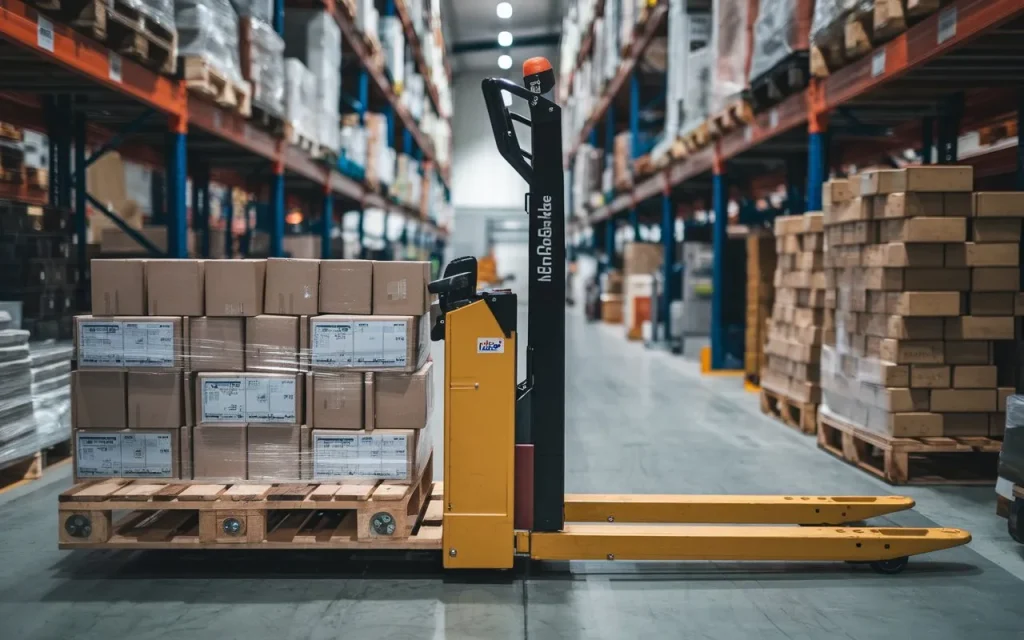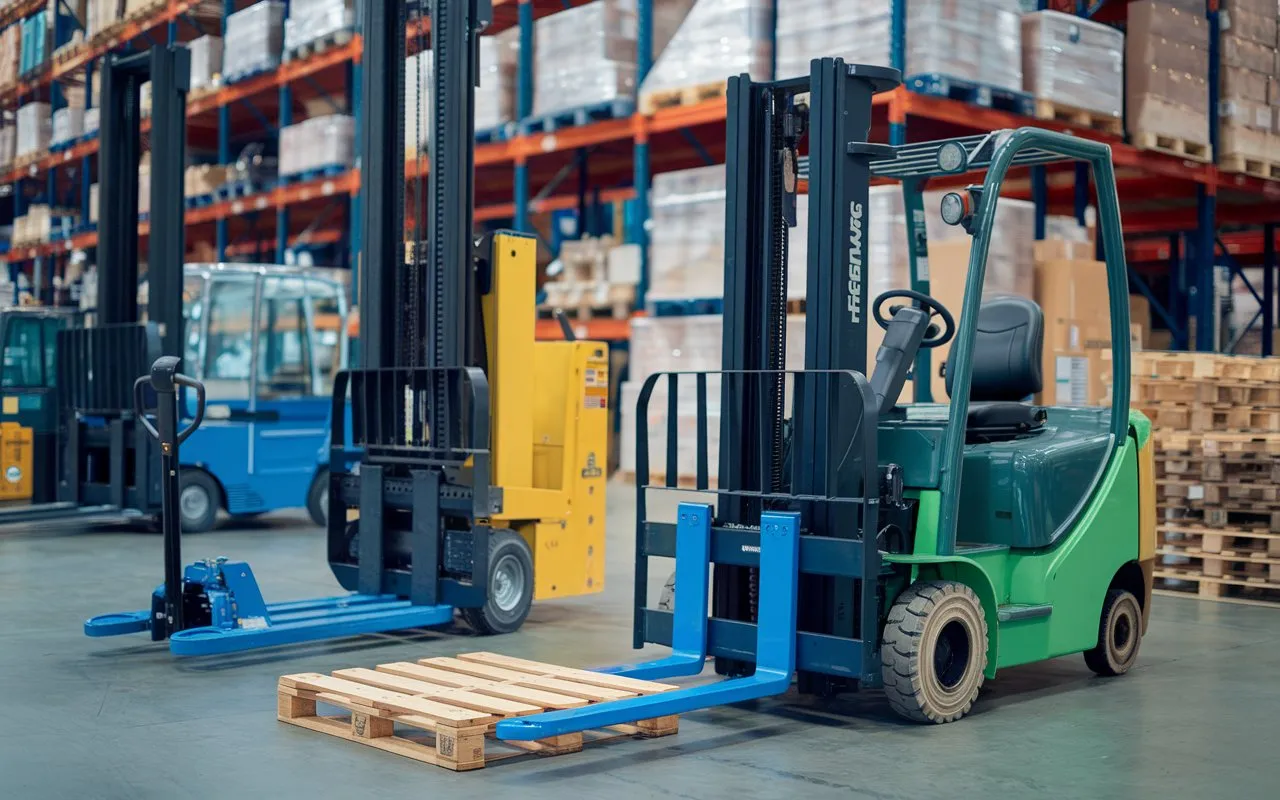Table of Contents
The right equipment is crucial for efficient transportation of pallet transport trucks. Agile pallet trucks are designed for back-friendly transport, making it easier for drivers to carry loads without strain. These trucks often have narrow dimensions, allowing them to manoeuvre easily in tight spaces like warehouses. Many of these trucks, such as manual pallet and high-lift trucks, feature hydraulics for easy lifting and loading.
Whether using a pallet jack or a forklift, the versatility of these trucks allows for the smooth lifting and transporting of pallets, enhancing overall productivity and making the workforce feel adaptable and resourceful.
The safety features of the right type of truck are paramount for commercial operations. Compact pallet trucks are excellent for horizontal transport in smaller areas, while pedestrian trucks provide a safer option for drivers working in busy environments.
Features like braking systems ensure safe operation, and some models even include a crane scale for precise load measurements. In my experience, investing in silent transporting equipment significantly reduces noise, especially in warehouse settings. Using the right transport tools improves efficiency and supports the hygienic transporting of goods, ensuring they arrive safely and cleanly at their destination.
Common Types of Pallets

Regarding pallet transport trucks in the logistics industry, the right equipment can make a big difference. These trucks are designed to handle the movement of pallets, which are used to carry goods across the supply chain.
Whether you’re dealing with Euro pallets or standard-sized options, knowing the key features that will streamline operations is essential. For instance, IBCs (Intermediate Bulk Containers) are often used to transport liquids in bulk, while nestable roll pallets are ideal for grocery stores needing to move items in storage quickly.
Durable options like plastic and composite materials offer long-lasting performance in handling light and heavy goods, perfect for agriculture and food processing industries.
In addition to standard options, specific tools like pallet movers and dolly platforms can enhance mobility on flat ground.
These are particularly useful in automated warehouse systems, where they can significantly speed up the movement of goods, reducing the time spent on manual handling and increasing overall productivity. HGV box trailers transport goods efficiently for domestic and international shipping in these systems.
Reusable containers made from plastic or metal can help safely and efficiently transport various products, especially those with irregular shapes or heavy weights. For businesses managing large volumes, roll pallet trolleys and wheeled carts make transporting grouped loads easy, reducing the time spent on manual handling and increasing overall productivity.
Vans of Logistic
Vans are essential to the logistics industry, especially for small businesses or short-distance deliveries. They can handle a wide range of pallets, whether standard or Euro, commonly used in the UK. Vans with short wheelbases are often preferred for these purposes.
These vans can easily carry standard-sized pallets while ensuring the weight is evenly distributed for safe transport. On the other hand, long-wheelbase vans are perfect for transporting more pallets and handling heavier loads over longer distances.
Depending on the weight and size of the pallets, the right vehicle is essential. Small vans are great for urban areas with tighter spaces, but larger vehicles are necessary for more extensive operations.
Using the right equipment ensures smoother operations and reduces delays in the supply chain, especially when dealing with Euro pallets that need to comply with UK transport standards. This balance between vehicle size and pallet weight is key to maintaining a seamless and efficient logistics process.
Common Types of Trailers

Choosing suitable trailers is vital to efficiently transporting containers in the logistics industry. Various trailers and configuration options exist for businesses dealing with shipping or intermodal containers. Flatbed trailers are ideal for large, stackable containers and are commonly used for road and rail transport.
Meanwhile, skeleton trailers, also known as skellie trailers, offer a lighter design, reducing dead weight and turnaround time. Temperature-controlled trailers, such as refrigerated containers, are perfect for temperature zones that require specific temperature requirements for perishable goods.
For a more flexible approach, businesses can opt for swap-body trailers. These trailers allow exchangeable containers to be easily transferred between different modes of transport like trains or HGV trucks. This reduces loading and departure delays and increases overall capacity and efficiency.
In my experience, optimizing the trailer height and using stackable configurations helps businesses lower costs while maximizing space for freight containers. Whether dealing with ambient or temperature-controlled transportation, having the right trailers ensures smooth operations and meets the specific transportation requirements of the goods.
Also Read: Understanding the Cost Breakdown of Auto Transport Solutions
Common Types of Trailers Chill-Chain guides – skellie, skeleton, shipping container
Choosing suitable trailers for transporting containers in pallet transport trucks is essential for keeping things moving efficiently. Skeleton (skellie trailers) are great for hauling shipping containers due to their lightweight design, which helps reduce dead weight and improve turnaround time.
Refrigerated containers are necessary for businesses handling temperature-controlled goods, like food or pharmaceuticals. These trailers maintain specific temperature zones to meet the strict temperature requirements of certain loads, ensuring that perishable items remain fresh during transit.
Another efficient option is swap-body trailers, where exchangeable containers can easily be switched between road, rail, or HGV trucks without much hassle. This cuts down on loading and departure time while maximizing capacity. I’ve seen how using flatbed trailers for intermodal containers can make transport between different modes— from trains to ships—much smoother, reducing overall costs. These trailers are highly efficient for long hauls, and their stackable design makes better use of available space.
Flatbed Truck
Large and heavy objects are best transported with flatbed trailers. Unlike enclosed trailers, flatbed trucks have an open platform with no sides or roof, making them perfect for carrying machinery, construction equipment, and building materials. In my experience, this type of trailer offers more flexibility when loading and unloading, especially when the cargo doesn’t fit in standard trailers due to its size or shape.
One significant advantage of using a flatbed trailer is its ability to transport items that would be too difficult to load into an enclosed space. The open design allows easy access from all sides, which is essential when dealing with bulky materials or specialized equipment requiring careful handling. This makes flatbed trucks highly efficient for industries that rely on transporting oversized loads across various job sites.
Articulated Trucks

In the transport industry, articulated vehicles are essential for moving large loads efficiently. These full-sized lorries have a pivot point that allows them to turn sharply, making them perfect for navigating tight spaces on job sites. They are commonly used in construction to transport heavy equipment and materials. An articulated vehicle can significantly improve the flexibility of transporting goods, especially in areas where traditional trucks might struggle.
The design of these vehicles allows for both permanent and semi-permanent attachments, enabling them to carry various types of trailers depending on the load. This versatility is a massive advantage in the logistics sector, as it means one vehicle can handle multiple transport needs. Whether you are moving pallets of building supplies or heavy machinery, an articulated vehicle can make the job easier and more efficient.
Rigid of Trucks
When discussing pallet transport trucks, it’s essential to understand the rigid trucks in the mix. A rigid truck has a fixed body and is a non-articulated vehicle, meaning the cab and the cargo area are one solid piece. This design makes it easy to handle and perfect for transporting pallets in various settings. Unlike articulated vehicles that can detach their main trailer, rigid trucks have all their wheels and cargo integrated, allowing for stability while driving.
Using a rigid truck for deliveries can make a big difference. They are instrumental in urban areas where space is tight, as they can manoeuvre better than larger articulated trucks. These vehicles are great for local deliveries and can quickly unload pallets at different stops without complicated setups. Understanding the difference between rigid and articulated vehicles helps businesses choose the right option for their logistics needs.
Tanker Trucks
In the transportation industry, tanker trucks are vital in transporting liquids and gases in bulk. These trucks come in various sizes and shapes to suit different needs. Made from materials like aluminium, steel, or fibreglass, they can safely carry fuel, chemicals, or food-grade liquids. Using the right tanker truck ensures that sensitive materials are delivered without contamination.
When loading and unloading, tools like pallet jacks and lift trucks are essential for handling the heavy loads associated with tanker trucks. My experience has shown that having the right equipment can significantly improve efficiency and safety. Whether moving heavy-duty chemicals or food products, using the correct tanker setup helps streamline the process and ensures compliance with safety standards.
Final Thoughts
The choice of trailer for pallet transport trucks is essential for efficiently transporting various types of goods. Closed trailers with rectangular bodies provide excellent protection for perishable items during transit.
Many of these trailers have a refrigeration unit to maintain controlled temperatures, ensuring that temperature-sensitive products arrive safely. The tailgate at the rear makes loading and unloading much more accessible, allowing for quick access to the cargo area, especially in busy environments.
These trailers come in multiple sizes, making them suitable for smaller deliveries and larger loads of industrial equipment. The flexible curtain sides offer convenient access while protecting the contents from weather conditions.
With wheels designed for stability, these vehicles can effectively haul heavy loads, allowing for efficient loading and offloading at any location. In my experience, having the right trailer makes all the difference in maintaining operational efficiency and protecting valuable goods during transportation.
FAQs:
What are pallet transport trucks used for?
Pallet transport trucks move goods stacked on pallets, making it easier to transport and load items efficiently within warehouses and across supply chains.
Can pallet transport trucks handle heavy loads?
Yes, many pallet transport trucks are designed for heavy-duty use and can efficiently lift and carry large, heavy loads.
What types of pallet trucks are available?
There are manual, electric, and high-lift pallet trucks. Each type is suited for different load capacities and operational needs, from small warehouses to industrial environments.

